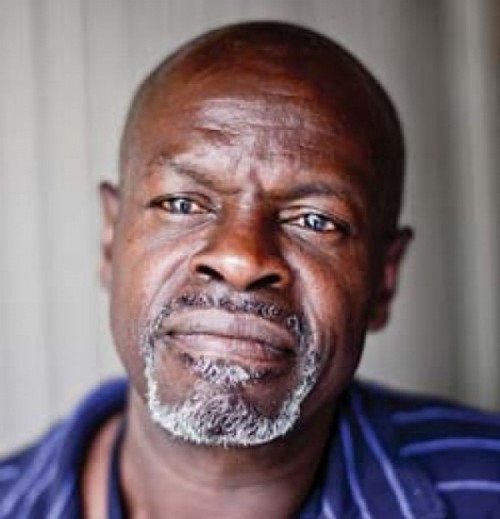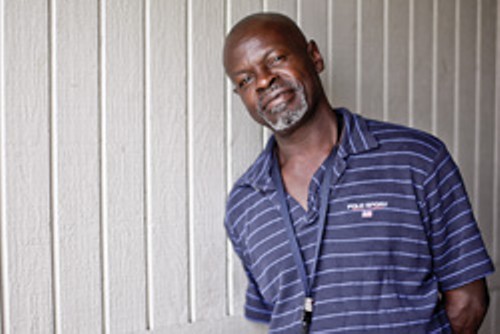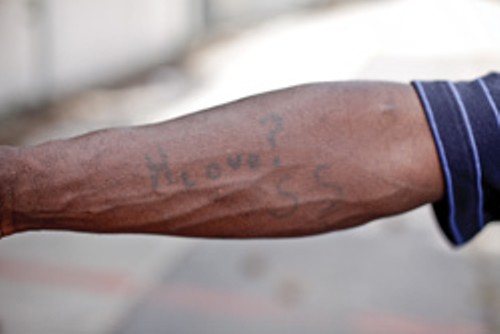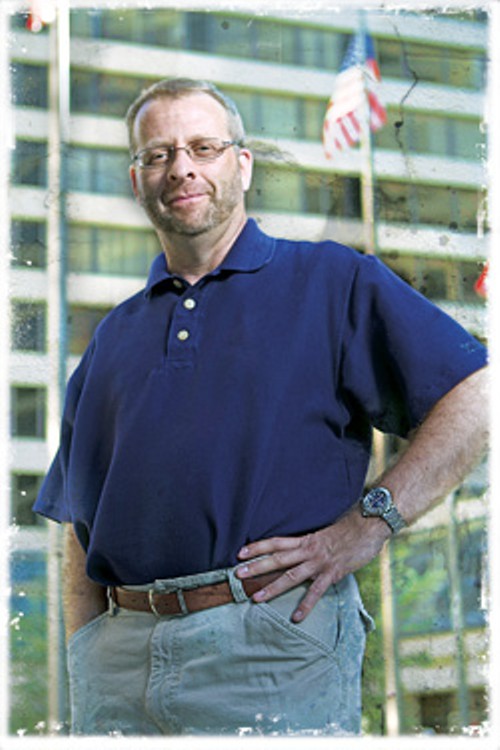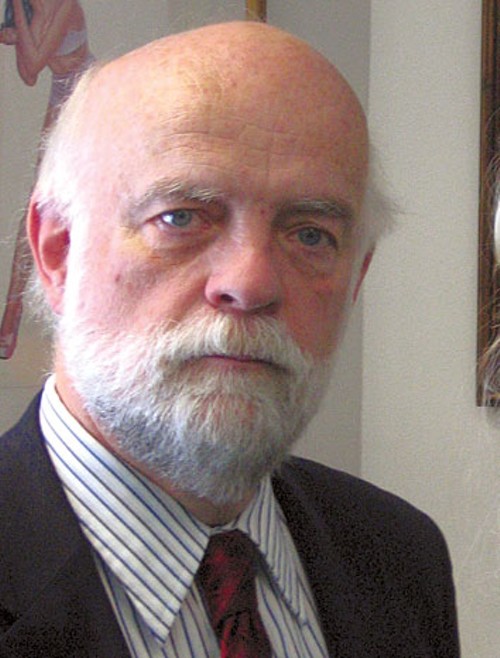An Innocent Man
Harry Miller tries to reclaim his life after spending years in prison for a crime he says he didn’t commit.
By Stephen Dark @stephenpdark“Mr. Miller,” the Utah state prison guard said. “Pack up your shit and get out.” Harry Miller stood in his cell and cried uncontrollably, as cellmates put his few possessions in a box. “I figured I’d never get out,” he says. “I was just too happy to move.”
As the 53-year-old walked through the prison just before 2 p.m. on July 6, 2007, other prisoners clapped and cheered the African-American from Donaldsonville, La. In 2003, a 3rd District Court jury convicted him of aggravated robbery, and Judge Sheila McCleve sentenced him to five years to life. He didn’t do the crime—snatching a woman’s purse at knifepoint—he told fellow inmates, because he’d been thousands of miles away in Louisiana recovering from a stroke when the crime was committed.
“Taking somebody’s life away, that’s hard,” Miller says, reflecting on his four years of hard time in a growly, Southern accent. “Losing all those years I’ll never get back again.”
In prison, he says, you accumulate “the weight” of worrying about doing or saying something that earns you additional prison time. As he walked out of the gate and felt the sun on his skin, “all that weight left my body.”
Jensie Anderson of the Rocky Mountain Innocence Center [RMIC] hopes to have Miller declared “factually innocent” under a 2008 statute so he can receive $115,000 in compensation for his three years behind prison bars post-sentencing. (A year Miller spent in jail awaiting trial is apparently not included.) Anderson—a University of Utah law professor who runs the federally funded nonprofit RMIC’s innocence clinic staffed by law students—says the evidence of Miller’s innocence is simple: “Harry wasn’t in the state [at the time of the crime]. I have no doubt of that. It’s a simple case of mistaken identity. Not only was he not in the state, he was ill, recovering from a stroke.”
Miller’s wrongful conviction highlights the issue of faulty eyewitness identification. Nationally, out of 273 inmates exonerated of their crimes through DNA testing, 204 of the convictions involved eyewitness misidentification. Even more disturbing, national eyewitness expert and University of Iowa psychology professor Gary Wells says, conservatively, only “5 percent of eyewitness-identification cases […] can produce DNA tests to ‘trump’ an eyewitness identification.” This means that for every one of the 204 exonerations, “there should be another 19 [wrongful convictions] that could never be overturned by DNA because there was no DNA evidence to be analyzed.”
Miller’s tragedy is inevitably bound to that of his alleged victim, former Salt Laker Julia Smart, who not only lost the justice she thought she had after he went to prison, but also arguably has to wrestle with her own guilt that she helped put an innocent man behind bars. For the eight jury members deliberating on faulty evidence, finding an innocent man guilty must similarly have echoes of guilt and anguish.
Anderson notes that Utah is one of only two states that have innocence statutes on its books. Indeed the Utah Attorney General’s Office pushed hard for Utah signing into law the 2008 Exoneration and Innocence Assistance Bill. “This new law [also] affirms our obligation to provide a compassionate response in those rare cases where the wrong person is sent to prison,” Attorney General Mark Shurtleff said in a press release.
So why, wonders a bewildered Anderson, “do they now not want anyone to use it?” She is referring to the AG’s decision in late May to appeal Deborah Brown’s exoneration of a murder a judge ruled in March she did not commit after she had served 17 years in prison. But Miller’s case is different. Attorneys on all sides, including the attorney general, agree his case is rare. Given that rarity, argue Miller’s supporters, why did it take the legal system so long to first release an innocent man, and now, hopefully, acknowledge to the world that a mistake was made? If Miller were an example, Scott Reed of the attorney general’s office says, “of one time [when the system was fallible] and we accept that, then we are going to correct it.”
Anderson says Miller, who currently works part-time as a landscaper for Salt Lake County, was “failed by the system through the police investigation, through his arrest, his trial, his appeal.” His petition to be declared factually innocent is “an opportunity for the system to at least attempt to make it right.”
STRUCK DUMB
When then-10-year-old Harry Miller’s widowed mother died in the Mississippi River-bordered town of Donaldsonville, La., Harry was too young to go to the funeral. “I was hurt,” he recalls. “I wanted to do something to remember I don’t like to be hurt at all.” He took a pen and tattooed five letters and a question mark on his arm. Almost 50 years later, ‘Hlove?’—the H standing for Harry—is still visible in his flesh.
He worked in a shoe warehouse, got married and had two girls. “Soon as I got married, I was the happiest man in the world.” Eighteen years later, he and his wife split up. He moved to Salt Lake City in 1989 to join his brother. He’d spend his days working, return to his hotel room in downtown Salt Lake City, shower, drink beer and watch TV. Ten years later, on Feb. 15, 1999, after a drunken altercation with police officers, he pleaded guilty to five misdemeanors, including two for assaulting cops. A ticket for spitting later that year made him “feel like it was time to leave [Salt Lake City], something wasn’t right.”
He moved back to Donaldsonville and worked from May 2000 at a vending-machine business. On Friday, Nov. 24, 2000, walking back to his home two blocks from work, he started dragging his leg. He couldn’t find the key to his apartment. A neighbor asked what was wrong as Miller leaned against the wall. All he could do was shake his head. He was taken to a local hospital where doctors diagnosed he’d had a stroke. These were facts the trial court under Judge McCleve would later acknowledge occurred.
Four days after hospital admittance, without insurance, Miller was well enough to be sent home in the company of a work supervisor and his sister. Hospital records show Miller needed home assistance and was slated to receive speech, occupational and physical therapy at his sister’s home.
The records also note Miller was “able to ride in a car only when driven by another person,” or use a bus “only when assisted or accompanied by another person.” Miller recalls it took him five minutes just to stand up. “The blood had to get to my feet. I just couldn’t move.”
On Dec. 7, according to an affidavit, a registered nurse providing home health care visited a recovering Miller, leaving at 11:02 a.m. She saw him again seven days later, one day before he returned to work.
Early on Dec. 8, thousands of miles away in Utah, a crime took place that a Utah jury would decide, three years later, had been committed by Miller.
SHAKE, RATTLE AND JAIL
On that cold wintery morning in 2000, Julia Smart pulled up outside the Fast Track Mart at 610 N. 400 West in Salt Lake City to get coffee and cigarettes. She was in a hurry and left the car running. Someone grabbed her as she walked back to her car. An African-American male she described to the police as between 18 and 21 years old [Miller would have been 47 at the time]—an age estimate she later questioned giving in court—mumbled something several times she didn’t understand. Finally, he made himself clear: “I’ll cut you. Give me your purse.” Then she realized he had a knife to her throat.
He took her purse and got in her car but couldn’t get it out of park. The store clerk called the police. He and Smart stood by the car, watching the man for several minutes, before he gave up and, the clerk testified, ran away.
The robbery impacted Smart badly. “It makes me shake,” says Smart, who moved to Hawaii with her husband, Brandon Smart, in part to escape Utah. Over the next several years, she saw several men she thought may have been her attacker.
In February 2002, Harry Miller quit his vending-machine job and returned to Salt Lake City. Although he was living in a men’s shelter, he enrolled in a Salt Lake Community College course to study hazardous-waste management. Work in hazardous waste “paid $25 an hour. I thought I’d have me a good job, a nice home.”
The bizarre confluence of events that would take away his freedom gathered momentum on Feb. 11, 2003, when Julia Smart was having dinner with her husband in a now-closed Dee’s restaurant on North Temple. An African-American man entered the restaurant and forced a waitress at gunpoint to open the till. Julia Smart had her back to the crime, but Brandon says he saw the robbery take place. “I had a very clear view. I know what I saw. I trust my own eyes.”
The police took Brandon to a few nearby bars, pulled out several men, but none of them were the robber. Then, several hours later, as Brandon and Julia were driving home, a man crossed the street immediately in front of the Smart’s car near the Dee’s restaurant and then used a pay phone. Brandon identified him to both his wife, and later the police, as the robber. Julia says she did not see the face of the man she and her husband observed and would later learn was named Harry Miller.
But when the police picked up Miller that same night, two witnesses to the Dee’s robbery said he wasn’t the assailant. Miller was nevertheless arrested by police for an outstanding warrant stemming from his 1999 spitting citation and held in jail while they investigated the Dee’s robbery.
Several days later, a police officer knocked at the Smart’s home, wanting Brandon to look at a photo lineup, but he was still at work. The officer asked Julia if she would look at the pictures, even though she hadn’t seen the restaurant robbery. When she saw Miller’s face in the line-up, she recalls, “my heart and stomach sank to the ground. I instantly remembered the day I was robbed.” She told the officer, “I don’t know who robbed Dee’s but this guy robbed me.” It wasn’t simply the visual recognition, she says during a phone interview from Hawaii, it was the emotional impact “when you see someone who did something bad to you.”
Eyewitness expert Gary Wells says eyewitnesses virtually never accept they have made a mistake. When shown a photo lineup, “they can pick up information from a photo without realizing it, so that person becomes her memory of the person who robbed her.” As soon as a witness decides, “That’s the guy,” Wells continues, “that person’s face becomes their memory.”
WITHOUT HOPE
Miller was held in the Salt Lake County lock-up for almost a year, awaiting trial on the Dee’s and Julia Smart robberies.
His defense counsel, then Salt Lake City legal defender John O’Connell, got Miller’s hospital records from Louisiana and arranged for Miller’s sister to travel to Utah to testify she had cared for him every day during the three weeks he was off work. But a month before the trial, she changed her mind. Her son was facing juvenile court issues in Louisiana, and she didn’t want to leave him alone. “At that point, [O’Connell] lost all interest,” Miller says. “He gave up after my sister said she couldn’t come. That hurt.” O’Connell, who is now a legal defender in San Diego, did not respond to e-mail and voice-mail requests for interviews. He told The Salt Lake Tribune’s Stephen Hunt in a 2007 story on Miller, though, that in hindsight, he “should have done more follow-up, especially with the home health-care nurse.”
When Miller saw Julia enter the court, seven months pregnant, watched by a mostly white jury, in front of a white judge, he knew he was going to prison. What got him, he says, “was I’d never seen her in my life.”
Salt Lake County prosecutor Kenneth Updegrove called Julia Smart and the convenience-store clerk to the stand almost three years after the crime. Both identified Miller. But the clerk also claimed to have seen Miller months prior to the robbery, when the court had accepted that Miller was working in Louisiana. Updegrove, since retired, points out that the robber’s slurred speech and inability to get the car out of park “seemed to be consistent with having a stroke previously. Julia and the clerk were standing there, staring at him. He had very distinctive front teeth.” That distinction, he told the Tribune’s Hunt, was a gap in his front teeth. While in 2003, when Miller was arrested, he did indeed have, and still has, a distinctive gap. In 2000, at the time of the robbery, Miller says he had a gold tooth, which fell out in 2001. He pulls out two battered photo ID cards from that time period to prove his point. But while Miller pressed O’Connell to ask Smart and the clerk about his tooth, the matter wasn’t raised.
Updegrove says, “Here is someone who is involved in two robberies. If he’s trying to claim [the case] is made out of old cloth, and there’s no evidence, the jury went with us.” Nevertheless, Updegrove himself dismissed the Dee’s robbery charge “in the interests of justice.” While Miller had been wearing similar clothes the night of the Dee’s robbery to the man Brandon Smart saw at the restaurant, DNA taken from the robber’s hat did not match Miller’s.
O’Connell put Miller on the stand to recount the story of his stroke and to point out that, as a car mechanic, he knew cars and would have known how to get a car out of park. Beyond that, the defense faltered. “John O’Connell had nothing for me. I had nothing to stand on.” Although Miller’s brother attended court every day, O’Connell didn’t call him to testify that Miller was not in Salt Lake City at the time of the crime. Updegrove says, “I couldn’t help wondering why nobody in Louisiana or his brother took the stand to say, ‘No, he wasn’t [in Salt Lake City].’ ”
The jury found Miller guilty. “I figured that because I didn’t do nothing to get in prison, I’d be there for life. I had no hope at all.”
DEFYING LOGIC
Kent Hart was in the appellate division of the Legal Defenders Association in 2003. He automatically received Miller’s file and, after reviewing it, was struck by the absence of alibi witnesses.
Hart was convinced his then-LDA-colleague O’Connell had not done all he could to assist Miller in his defense, meaning that part of Miller’s case for his release would require looking at O’Connell’s performance in court. Then Utah County-based private attorney Patrick Lindsay took on Miller’s case. Hart told Lindsay, “This case is one of those rare opportunities to help a truly innocent person from an extreme injustice.” Lindsay flew down to Louisiana, interviewed witnesses and arranged for Miller’s niece to come to Utah to testify he was there in Donaldsonville at the time of the Julia Smart robbery.
Lindsay’s brief to the court of appeals summed up the original conviction pithily. “Here, the result was so unreliable as to approach the absurd. To propose that a man who lived and was gainfully employed in a small Louisiana town would—after being disabled by a stroke—somehow travel over 1,800 miles without any of his caretakers knowing it, immediately commit a random crime against a stranger with negligible gain, and get himself home without anyone noticing his absence, defies logic.”
The attorney general’s office, which automatically takes on appeals, saw Miller’s supposedly narrow window of travel opportunity as evidence he could have committed the crime. Then assistant attorney general Matthew Bates wrote in a brief, “Thus the evidence from defendant’s home-health-care records does not make it impossible for defendant to have committed the crime—it only narrows the time frame within which defendant could have traveled from Louisiana to Utah.” Miller, he continued, could have flown to Utah the afternoon of Dec. 7, 2000, robbed Julia Smart the next morning, “concluded his visit, and flew back to Louisiana to return to work on Dec. 13.”
The court of appeals sent the case back to Judge McCleve for a hearing to determine if John O’Connell had provided Miller with ineffective counsel, but Judge McCleve was unimpressed. Miller’s niece told the court she saw Miller every day and night while he was out off work, but then became confused on the stand. McCleve ruled her testimony was, “at best, not reliable.” Further, she ruled that there was “no reasonable probability of a different result [from Miller’s conviction] even if [the new witnesses] had testified.”
One month before the case went to oral arguments before the appeals court, the attorney general’s office, having vigorously refused to admit any fault in the court trial, had an abrupt change of heart. The state and Lindsay agreed to a reversal of the conviction on the basis of an undisclosed “error” in the trial. Reed says both sides agreed “something should happen but neither side could come up with a reason why. The result was appropriate. The reasons weren’t important.”
Lindsay says “the error” related to essential witnesses not testifying who “would have made a difference, and the fact that he was in Louisiana at the time of the alleged crime.” The state intentionally refused to identify the error, Lindsay says, since “if the court of appeals had decided the case on its merits and ruled against the state, that would probably have resulted in case law they would have preferred not to have on the books.”
Faced with a new trial, Miller also had a difficult decision to make. The district attorney’s office offered to release Miller if he pleaded guilty to second-degree robbery, with time served. “If you plead guilty today, you walk out,” Hart told Miller.
“But I didn’t do it,” Miller said. “I want to fight it.”
Five months later, prosecutor Kent Morgan declined to retry Miller and dismissed the case “in the interests of justice” on July 3, 2007. Three days later, Miller was a free man.
JUMPING ON THE BANDWAGON
After he was released, Miller wanted only to return to Louisiana. But first he sought to clear his name. Attorney Andrew McCullough took Miller’s case pro-bono, impassioned by what he saw as the injustice of the case. Through attorney friends, McCullough raised the bus fare so his client could return home. When Miller left Utah, “it felt damned good.”
In a matter of days after the innocence statute became law in April 2008, McCullough quickly filed Utah’s first innocence petition. Then-assistant-attorneys-general Erin Riley and Matthew Bates “came after us with both feet and both fists,” McCullough says. The AG’s Scott Reed says the petition—rather than providing evidence Miller was innocent—simply stated his innocence as a fact. “I can tell you 4,000 guys in Draper that would say ‘Hey, I’m innocent, too. Trust me on this,’ ” Reed says.
In a memorandum, the state claimed, “there is no compelling interest of justice that requires that a factual innocence hearing now be granted to petitioner in this case.” That statement, McCullough argued in court filings, “conveys total indifference as to whether an innocent man has been unjustly punished, and punished severely.”
In a ruling McCullough described as “chilling,” Judge McCleve granted the state’s motion to dismiss Miller’s petition. McCleve wrote contradictorily that, “Although the [new] evidence makes it unlikely that Petitioner committed the crime,” her court had already reviewed the evidence and determined it wouldn’t have changed the result of the trial.
In 2009, Miller, after working for a time at a Donaldsonville fried-chicken restaurant, took a bus back to Utah. After he cashed a Social Security check for $2,000 and rented a South Salt Lake apartment with a girlfriend, she accused him of hitting and choking her. They sought protective orders against each other, and he pleaded guilty to a misdemeanor assault charge in exchange for probation. “Maybe I’m just not supposed to be in Utah,” he says. Sentenced to 90 days in jail, with credit for time served, he was released. He later took a reduced guilty plea for an attempted drug-possession charge. McCullough is appealing both convictions.
After McCleve dismissed the innocence case, McCullough appealed her decision, with the Rocky Mountain Innocence Center providing assistance a year later in the form of an amicus brief. On Feb. 4, 2010, the appeals court ruled on Miller’s challenge to McCleve’s decision.
The court said that Miller’s petition raised “a justiciable bona fide issue of factual innocence,” namely that “Miller’s commission of the underlying offense, although not impossible, is highly debatable because of both physical and temporal limitations.” Not only did the stroke limit his movement, but he only had 24 hours to “fly from his recovery bed in Louisiana to Utah in order to commit an act of physical violence against a complete stranger.”
Miller, the court concluded in what Reed labeled “a fairly tortured reading of the statute,” nevertheless, “may receive the factual-innocence hearing to which he is statutorily entitled.”
WILL THIS NEVER END?
After the appeal court’s decision, McCullough handed over the case to the Rocky Mountain Innocence Center, which has the resources to develop the evidence the attorney general needed to declare Miller an innocent man. In mid-March 2011, RMIC’s Jensie Anderson gave assistant attorney general Scott Reed what she says amounts to the “full story” of how Miller came to be wrongly convicted. Along with securing affidavits from residents of Donaldsonville providing a detailed timeline of Miller’s movements, which, Anderson believes, puts Miller “definitely there the whole time,” RMIC has also highlighted questions surrounding the eyewitness identification. Other evidence Anderson and her students have marshaled for the attorney general include a witness saying she saw Smart’s attacker running from the scene of the crime and then jump a 6-foot-high fence—an impossible feat for Miller post-stroke.
While Brandon Smart remains convinced Miller committed both his wife’s assault and the Dee’s robbery, as Julia Smart talks over her memories of living with the assault, the trial, then finding out through a news story that Miller had been released, her anger focuses on the state of Utah. “There’s definitely some injustice going on in the Utah state government, obviously on both sides,” she says. If Miller wants to continue fighting, “more power to him.”
She did what she felt was right. “I’m pretty much over it, I don’t want to have to deal with it.” She admits, however, she is angry that “the state believed him over me. I was right there in front of him.” She expresses concern over people’s perception of her testimony. “What character does that leave me with?”
National eyewitness expert Wells feels bad for Julia. “She was clearly victimized originally; now she’s in this never-ending saga where, in a sense, she was victimized again, by this mistaken-identification problem. Now she’s got to live with that.” The public will look at what she did, he argues, leaving her to ask herself, he continues, “ ‘Will this never end?’ ”
Reed believes that, “unless there is shattering evidence that implicates Mr. Miller,” the case will be wrapped up before the end of the year. Anderson says that hopefully with the additional alibi evidence and “new” evidence she and her team have gathered, “the AG will stipulate to Harry’s innocence without an evidentiary hearing.” Reed says he wants to check through the evidence. “Right now, we are in the ‘trust-but-verify’ mode,” he says, paraphrasing a quote from former President Ronald Reagan.
That doesn’t cut much slack with former Miller attorney Kent Hart. Look at the timeline, he says. Miller was wrongfully convicted in 2003. Now, at the end of 2011, if the state concurs, Utah will finally acknowledge a mistake was made. “The bottom line is everyone knows Harry Miller is innocent. So, we have to verify for eight years?”
As much as the restitution money would allow Miller to finally buy a home in the Louisiana countryside, away from the city, where he could drink beer on his front porch in the cool of the evening, what he most wants is an apology from Julia Smart and the state of Utah. An apology from Smart seems unlikely. As to the state, Reed says, “If the evidence is there to support [Miller’s innocence], then I will be the first to go to the Legislature and the governor and say this man is factually innocent.”
Miller, with his raspy laughter and his sadness, lives with the knowledge that if he had not had a stroke, he might well still be in prison. He says his bid for an innocence declaration “is about trying to open that door to live again.” Some nights, he lies in bed, thinking about his life “and cries like a baby. Sometimes you can’t help the way life be treating you.”
More by Stephen Dark
-
Call it a Comeback
Long mired in economic depression, Midvale’s Main Street dusts off its small-town charm.
- Sep 20, 2017
-
Love Letters
Correspondence between a young woman at the Topaz internment camp and her beloved sheds light on Trump's America.
- Sep 6, 2017
-
Triggered
Veterans Affairs exists to help vets. So why did the Salt Lake VA appoint an anti-veteran chief?
- Aug 30, 2017
- More »
Latest in Cover Story
Readers also liked…
-
Forget the family pedigree—Robert F. Kennedy Jr should not be the next president of the United States
Trojan Horse
- Jun 21, 2023
-
Women decry harassment and toxic culture at St. George auto dealership
Men at Work
- Oct 11, 2023


